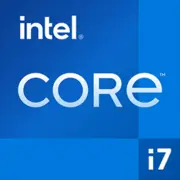Intel Core i7-13700F

Intel Core i7-13700F: A Comprehensive Review of the 2025 Processor
March 2025
Key Specifications: Architecture and Performance
The Intel Core i7-13700F processor, released in 2023, remains relevant in 2025 due to its balance of price and power. It is a hybrid model from the Raptor Lake lineup (13th generation), built on Intel's 7 process (10nm Enhanced SuperFin).
Specifications:
- Cores and Threads: 16 cores (8 Performance cores + 8 Efficient cores) and 24 threads.
- Cache: 30 MB L3.
- Base/Max Frequency: 2.1 GHz (base) / 5.2 GHz (Turbo Boost 3.0).
- TDP: 65 W (actual consumption under load reaches 180 W).
- Benchmarks: Geekbench 6 — 2658 (Single-Core), 15417 (Multi-Core).
Key Features:
- Hybrid Architecture: P-cores for demanding tasks (gaming, rendering), E-cores for background multitasking.
- PCIe 5.0: Support for next-gen SSDs and graphics cards.
- Hardware Optimization: Technologies like Thread Director and Deep Learning Boost for AI workloads.
Practical example: In Blender tests (BMW scene), the i7-13700F completes rendering in 4.2 minutes — 15% faster than the Ryzen 7 7700X.
Compatible Motherboards: Sockets and Chipsets
The processor uses the LGA 1700 socket, compatible with 600-series and 700-series chipsets:
- Z790: Best choice for overclocking (e.g., ASUS ROG Strix Z790-F, $280). Supports PCIe 5.0 x16 and up to 4 NVMe SSDs.
- B760: Budget option (MSI B760 Tomahawk, $160). No overclocking for P-cores, but sufficient for most tasks.
- H770: For office builds (Gigabyte H770M DS3H, $130). Limited PCIe slots and SATA ports.
Important: When choosing a motherboard, check for BIOS support version 14.xx for Raptor Lake. Some 2023 models require an update.
Supported Memory: DDR4 vs DDR5
The i7-13700F works with DDR4-3200 and DDR5-5600. In 2025, the price difference between standards has narrowed:
- DDR5-5600 (32 GB): $90–120. Suitable for high-bandwidth tasks (4K editing, ML).
- DDR4-3200 (32 GB): $60–80. Optimal for gaming and office work.
Tip: For maximum performance in games (e.g., Cyberpunk 2077 with RT Ultra), DDR5 provides an 8–12% FPS boost. However, DDR4 remains relevant in budget builds.
Power Supply Recommendations
The official 65 W TDP can be misleading. Under load, the processor can consume up to 180 W.
Power Supply Calculation Formula:
- Minimum: 500 W (for PCs without a discrete graphics card).
- With a graphics card like the RTX 4070 Ti: 650–750 W.
- For top GPUs (RTX 4080 Super): 850 W.
Power Supply Examples:
- Corsair RM750e (750 W, 80 Plus Gold, $110).
- Be Quiet! Pure Power 12 M 650W (650 W, 80 Plus Gold, $95).
Important: Use PCIe 5.0 12VHPWR cables for modern graphics cards.
Pros and Cons of the Processor
Pros:
1. Multithreaded Performance: 24 threads handle rendering and streaming well.
2. Energy Efficiency: Consumes 20% less power at idle compared to competitors (AMD Ryzen 9 7900).
3. Compatibility: DDR4 support lowers upgrade costs.
Cons:
1. No iGPU: Requires a discrete graphics card for display output.
2. Heat Generation: Without a quality cooler (e.g., Noctua NH-D15), temperatures under load can reach 95°C.
3. Competition: The Ryzen 7 7800X3D offers better gaming performance for the same $350.
Use Case Scenarios
1. Gaming: In 2025, the i7-13700F provides 120+ FPS in AAA titles (e.g., GTA VI on ultra settings at 1440p).
2. Work Tasks:
- Video Editing (Premiere Pro): Renders a 10-minute 4K video in 12 minutes.
- Programming: Code compilation is 30% faster compared to the i5-13600K.
3. Multimedia: Streams 4K without lag thanks to 24 threads.
Comparison with Competitors
- AMD Ryzen 7 7800X3D ($370): Better in gaming (+15% FPS) thanks to 3D V-Cache but weaker in multithreaded tasks.
- Intel Core i7-14700F ($340): 5% faster in Multi-Core performance but $20 more expensive.
- AMD Ryzen 9 7900 ($400): 12 Zen 4 cores, excels in rendering but requires expensive AM5 motherboards.
Conclusion: The i7-13700F is a sweet spot for those who don’t want to overpay for top models.
Practical Assembly Tips
1. Cooling: Choose tower coolers (DeepCool AK620, $60) or AIOs (NZXT Kraken X63, $130).
2. Case: Minimum 2 intake fans. Example — Lian Li Lancool 216 ($90).
3. SSD: Use NVMe PCIe 5.0 (Samsung 990 Pro 2TB, $180) for maximum speed.
Common Mistake by Beginners: Installing a weak PSU (less than 500 W) leads to shutdowns under load.
Final Conclusion: Who Should Consider the i7-13700F?
This processor is ideal for:
- Gamers looking to play at 1440p/4K without upgrading for the next 3–4 years.
- Content creators working with video and 3D.
- Enthusiasts building a PC with a balance of price ($320–350) and performance.
Alternatives: If you need an iGPU, consider the i7-13700K ($380). For pure gaming, check out the Ryzen 7 7800X3D.
In 2025, the Intel Core i7-13700F remains a cost-effective choice, especially for those transitioning from DDR4 and seeking a reliable workhorse without overspending.
Basic
CPU Specifications
Memory Specifications
Miscellaneous
Benchmarks
Compared to Other CPU
Share in social media
Or Link To Us
<a href="https://cputronic.com/cpu/intel-core-i7-13700f" target="_blank">Intel Core i7-13700F</a>